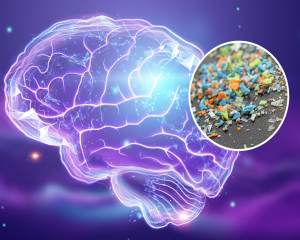This study published today confirms the presence of MNPs in the brain—and at shocking levels.
今天发表的这项研究证实了纳米塑料在大脑中的存在,而且含量惊人。
The study examined 52 human brain samples from 2016 and 2024, all taken from the frontal cortex, the part of the brain responsible for judgment, decision making, and muscle movement.
研究分析了2016年和2024年的52个人类大脑样本,所有样本均取自大脑额叶皮层,这是负责判断、决策和肌肉运动的部分。
The researchers also looked at liver and kidney samples from the same bodies, analyzing all tissue using microscope imaging and molecular analysis to identify the chemical composition.
研究人员还检查了同一批样本的肝脏和肾脏,通过显微镜成像和分子分析来确定组织的化学成分。
Brain and liver samples from 2024 had significantly higher concentrations of MNPs compared with those from 2016.
与2016年相比,2024年的大脑和肝脏样本中MNPs的浓度显著增加。
The total mass of plastics in the brains studied increased by about 50 percent between 2016 and 2024, and the researchers suggest drastically increasing concentrations of MNPs in our homes, air, and water could be to blame.
研究发现,2016年至2024年间,大脑中塑料的总质量增加了约50%,研究人员认为,这可能是因为我们家中、空气和水中的纳米塑料浓度急剧上升。
"I'm quite shocked by the amount of microplastics they find," says Emma Kasteel, neurotoxicologist at Utrecht University in the Netherlands. "It was a lot higher than I would have expected."
荷兰乌得勒支大学的神经毒理学家艾玛·卡斯特尔表示:“我对他们发现的微塑料数量感到震惊,这比我预期的要高得多。”
Growing levels of microplastics in the environment are reflected in the new findings, says Kasteel, with more exposure likely the cause of more plastic particles in the organs.
卡斯特尔指出,环境中的微塑料水平不断上升,这在新研究中得到了反映,更多的暴露可能是器官中塑料颗粒增加的原因。

The brain samples overall had 7 to 30 times more MNPs compared with liver and kidney samples.
与肝脏和肾脏样本相比,大脑样本中的纳米塑料含量高出7到30倍。
Particles found in the brain were mostly tiny shards or flakes of polyethylene, one of the most common plastics in the world, often used in packaging.
大脑中发现的颗粒主要是聚乙烯的微小碎片,聚乙烯是世界上最常见的塑料之一,常用于包装。
It makes sense that MNPs accumulate more in the brain compared to other organs, says Kasteel.
卡斯特尔解释说,纳米塑料在大脑中的积累比其他器官更多是合理的。
Inhalation through the nose to what's called the olfactory bulb, the part of the brain that processes smell, gives MNPs in the air a more direct route to the brain than to other organs.
通过鼻子吸入的空气会进入大脑的嗅球,这是处理气味的部位,这使得空气中的MNPs比其他器官更容易直接进入大脑。
Campen points out the age of the person was not associated with the amount of plastic in the organs, meaning the body does clear the plastic in some way -- if not, older individuals' organs would just continue to accumulate more and more plastic over the years.
坎彭指出,器官中的塑料含量与年龄无关,这意味着身体会以某种方式清除塑料--否则,老年人的器官会随着时间的推移积累越来越多的塑料。
Another notable finding was that MNP levels were about three to five times higher in 12 brains from people who had been diagnosed with dementia.
另一个值得注意的发现是,在被诊断为痴呆症的12个大脑中,纳米塑料水平高出3到5倍。
The researchers clarify this does not necessarily mean MNPs cause dementia, but it shows an association that should be studied further.
研究人员澄清说,这并不一定意味着纳米塑料会导致痴呆症,但它表明了两者之间的关联,值得进一步研究。
Kasteel says the connection is likely because people with dementia tend to have blood-brain barriers that don't function as well as a filter as in healthy people, meaning the high concentration of MNPs could be a consequence of dementia rather than a cause.
卡斯特尔认为,这种关联可能是因为痴呆症患者的血脑屏障功能不如健康人那样有效,这意味着高浓度的纳米塑料可能是痴呆症的结果,而不是原因。



